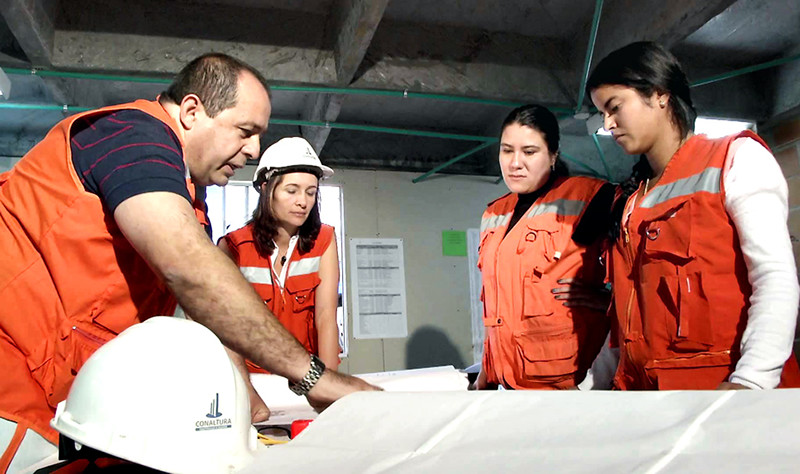
Near the Colombian city of Itagüí, new apartment buildings are helping to re-define “green growth.” © CC BY-SA 4.0, Link
This story is part of a series on IFC’s work to help create markets that give new opportunities to people in developing countries. These innovative approaches have helped solve some of the largest problems in countries or, sometimes, entire regions.
Also available in: Spanish
 Urban housing isn’t known for being green, but a new apartment building in Colombia—going up in a forest located in a fast-developing metropolitan area—is helping to re-define “green growth.” VerdeVivo, a sustainable housing project created by the construction company Conaltura, meets high-level international environmental standards that guarantee sustainability from the planning phase onward.
Urban housing isn’t known for being green, but a new apartment building in Colombia—going up in a forest located in a fast-developing metropolitan area—is helping to re-define “green growth.” VerdeVivo, a sustainable housing project created by the construction company Conaltura, meets high-level international environmental standards that guarantee sustainability from the planning phase onward.
Residents of this building know they’ll save on bills for energy consumption, and help the environment by generating lower carbon emissions. Better air quality is another benefit. But VerdeVivo’s families may not know that their new homes are an essential part of Colombia’s Green Growth Strategy, which includes adherence to national green building codes.
IFC, anticipating a need for new financial products for this untapped market, created incentives to encourage the financial and construction sectors to coordinate efforts. Bancolombia and Davivienda, the largest commercial banks in the country, worked with IFC on issuing a total of $260 million in green bonds to support climate projects, including green buildings. VerdeVivo, for example, was constructed with green-bond financing from Bancolombia.

© Conaltura
Such innovations are helping Colombia meet its national targets for reducing greenhouse emissions. Colombian buildings are expected to consume 10 to 45 percent less energy and water, and these reductions will avoid nearly 190,000 metric tons of greenhouse emissions by 2021. Ultimately, this will help big cities like Bogota reduce emissions by 16 percent in 2019, relative to 2007 figures.
Constructing a New Market
Colombia is among the top 20 fastest-growing markets in terms of construction spending. Implementing green building codes can make a substantial impact on national economic development —and that’s why the Colombian government sought to create specific requirements to ensure the sustainability of the new commercial and residential buildings.
Government officials requested IFC’s support in developing these national green building codes to make sure the codes were designed as instruments to promote energy efficiency and water conservation in building construction. The codes were created with cost-benefit considerations in mind—as well as local climatic and structural construction characteristics.
To measure climate- and energy-related indicators more effectively and comply with green building codes, the National Chamber of Construction (Camacol) endorsed voluntary certification from IFC’s Excellence in Design for Greater Efficiencies, or EDGE, initiative. EDGE software and certification helps planners create resource-efficient designs.
Colombia’s green building codes were enacted in 2015 with the support of Camacol; Colombia’s Ministry of Housing, City, and Territory; the Ministry of the Environment; and the Ministry of Finance. In partnership with Camacol, IFC also facilitated and promoted public-private dialogue and participation in this process.
Green Finance Gets the Green Light
Private-sector interest in complying with Colombia’s green building codes is significant. This set the stage for IFC to introduce incentives for the financial sector to develop original financial products such as green bonds. Bancolombia and Davivienda worked with IFC to issue green bonds in support of climate-smart projects.
Davivienda’s $149 million green bond, purchased by IFC, was the largest green-bond issuance by a private financial institution in Latin America. Davivienda is using the funds from the green bonds to finance the construction of two large green office buildings. One of them will consume about 48 percent less water compared to other similar-sized office buildings—and its energy consumption will be slashed by about 35 percent. Low-emission cars will have preferential parking spots.
Bancolombia’s green-bond financing of Conaltura resulted in the VerdeVivo housing developments between the municipalities of Itagui and La Estrella. With EDGE certification, owners in one of the Colombia’s new VerdeVivo buildings can save at least 25 percent in energy bills and 29 percent in water , compared with a conventional home. Depending on the building type and particular climate, other new buildings built under the codes are reducing energy and water consumption by up to 45 percent.
Beyond the building codes’ environmental impact, they are inspiring innovation in building design by encouraging the use of renewable energy, new types of materials, and clean technologies. The regulations take into account local conditions to set realistic targets for energy and water saving goals, creating a new benchmark for sustainable construction in the country.
IFC is committed to supporting the creation of green buildings across the globe . EDGE has been used to build residential and commercial buildings in nearly 100 countries—including homes and apartments, hotels and resorts, office buildings, health care facilities, and retail establishments.
For more information: www.ifc.org/climatebusiness.
Follow the conversation: #IFCmarkets
Published in December 2017